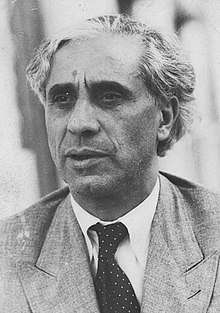Zia ol Din Tabatabaee
Seyyed Zia ol Din Tabatabaee (June 1889[1] – August 29, 1969; Persian: سید ضیاءالدین طباطبایی) was an Iranian politician and the Prime Minister of Iran (Persia) from February to May 1921 under Ahmad Shah, the last Shah of the Qajar dynasty.
Seyyed Zia ol Din Tabatabaee | |
|---|---|
 | |
| 18th Prime Minister of Iran | |
| In office 21 February 1921 – 4 June 1921 | |
| Monarch | Ahmad Shah Qajar |
| Preceded by | Fathollah Khan Akbar |
| Succeeded by | Ahmad Qavam |
| Member of Parliament of Iran | |
| In office 7 March 1944 – 12 March 1946 | |
| Constituency | Yazd |
| Personal details | |
| Born | June 1889 Shiraz, Iran |
| Died | 29 August 1969 (aged 80) Tehran, Iran |
| Resting place | Shah Abdol-Azim Shrine |
| Political party | Homeland Party |
Life and career
Born in Shiraz, Tabatabaee came to power in a coup d'état with the help of Reza Khan Mirpanj, who later became the Shah of Persia (which then came to be formally recognized as Iran by the international community), as Reza Shah Pahlavi.
When Tabatabaee became prime minister, he was 33 years old. His career did have an early start, however. In Shiraz, he first opened a newspaper called Banāy-i Islam (Foundations of Islam), followed by the newspaper Ra'd (Thunder) at the age of 23. After Ra'd was shut down by the authorities, he then published another newspaper called Bargh (Lightning), and became active in the Persian Constitutional Revolution.
His political tendencies were perceived to be pro-British by many Iranians and British diplomats. However, when he went into exile in the Palestine in the 1930s, he received money from fascist Italy and promised an oil concession in northern Iran.[2] The historian Ervand Abrahamian characterized Tabatabaee as a "right-wing opportunist".[2] In Palestine, he was also hired as a senior consultant by the government of Afghanistan with Britain's backing. Tehran's government vehemently objected to this move, leading Kabul to back down on the initiative.
Tabatabaee died at the age of 80 of a heart attack in Tehran. He was buried in Ray.
Sometime after his death, the ownership of Tabatabaee's house was transferred to SAVAK and was then converted into what is today known as Evin Prison, the main prison where political prisoners are kept, both before the Iranian Revolution and afterwards.
As a prime minister
It is argued by the historian Cyrus Ghani, that Tabatabaee was out of his depth when it came to governing [3]. He was an incompetent administrator who had grandiose agenda such as reorganization of ministries, granting lands to peasants, which never fully came to fruition [3]. The only plan of Tabatabaee that came to fruition was the closure of ships on Fridays and holidays, the end of sale and consumption of alcohol, and having calls to prayers at public buildings at noontime; these were motivated steps for the goal of getting greater support from the Ulama [3]. Moreover, the average Iranian thought of him as first being concerned about British interests [3].
References
- http://www.rouzshomar.ir/سید-ضیاء-الدین-طباطبایی-نفر-دوم-کودتای/
- Abrahamian, Ervand (2013). The coup : 1953, the CIA, and the roots of modern U.S.-Iranian relations. New York: New Press, The. p. 36. ISBN 978-1-59558-826-5.
- Ghanī, Sīrūs. (2000). Iran and the rise of Reza Shah : from Qajar collapse to Pahlavi rule. London: I.B. Tauris Publishers. ISBN 1860646298. OCLC 47177045.
- 'Alí Rizā Awsatí (عليرضا اوسطى), Iran in the Past Three Centuries (Irān dar Se Qarn-e Goz̲ashteh - ايران در سه قرن گذشته), Volumes 1 and 2 (Paktāb Publishing - انتشارات پاکتاب, Tehran, Iran, 2003). ISBN 964-93406-6-1 (Vol. 1), ISBN 964-93406-5-3 (Vol. 2).
- (seyed zia: marde aval ya marde dovome koodeta Author : elahi, sadredin ISBN 978-1-59584-312-8 انتشارات شرکت کتاب)
| Political offices | ||
|---|---|---|
| Preceded by Fathollah Khan Akbar |
Prime Minister of Iran 1921 |
Succeeded by Ahmad Qavam |
| Party political offices | ||
| Vacant Party founded |
Leader of the National Will Party 1943–1946 |
Vacant Party dissolved |